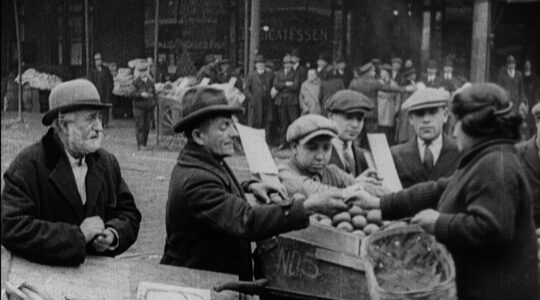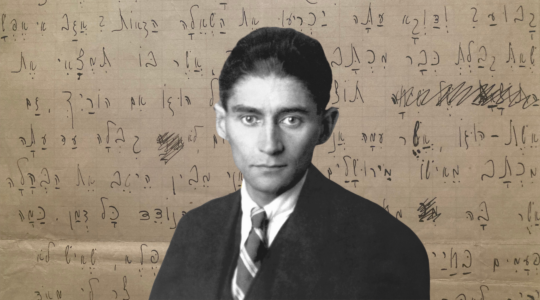Israelís economy is reeling. Unemployment is high, the state coffers are empty, 3,000 teachers are laid off, and thereís a 30-billion shekel deficit (Haaretz, March 17). Yes, we in America can ìbuy Israeli,î but thatís like throwing pennies in a fountain. Well, we dutifully tell each other, Israel is doing all she can.
A few miles from Jerusalem, Yasir Arafat is a very rich man, according to Forbes (March 17). The Palestinian Authority president is the sixth wealthiest government leader in the world, with at least $300 million in personal holdings. Israel places his wealth at $1.3 billion. On the Forbes list, he trailed only Arabian oil sheiks, old-line European royalty and Saddam Hussein.
Meanwhile, said Forbes, Israel has been sending ì$30 million or more per month in tax revenues to the PA [Palestinian Authority], disbursements that were frozen in December 2000 following an outbreak of terrorist bombings. Israel may even release the $500 million-plus that piled up during the freeze.î Presumably, thereís no longer a reason to freeze the money.
Forbes goes on: ìWith a tight grip on much of the $5.5 billion in international aid that has flowed into the PA since 1994, [Arafat] appears to have overseen virtually all disbursements,î including ìpayments to alleged terrorists.î
The magazine explained that Israeli officials began releasing tax proceeds to the Palestinians last July, ìbeginning with a trickle of $14 million payments, rising to $58 million in February,î some of it from ìexcise taxes of up to $8 million a month collected by Israel on oil sold to Palestinian-controlled areas.î
Palestinians are cashing checks from Iraq as well as Israel. Reuters (March 14) noted that a suicide bomber and families of Palestinians killed by Israel received $245,000 in checks from Saddam Hussein last week, a story as underreported as Israelís monthly payoffs.
n
On the far right (Pat Buchanan in The American Conservative) and the far left (Columbia Universityís Edward Said in Counterpunch.org), we heard identical language: a Jewish ìcabalî is dragging America into war to protect Zionist interests.
There were similar charges from racist agitator David Duke and Rep. Jim Moran (D-Va.), who said, ìIf it were not for the strong support of the Jewish community for this war in Iraq, we would not be doing this. The leaders of the Jewish community are influential enough that they could change the direction of where this is going.î
Zev Chafets in the Daily News (March 12) said ìthe alert patriots of the Aryan Nation have sounded the warning about devious American Hebrews, and New York Times columnist Maureen Dowd has demurely hinted at it a time or two.î
Jonah Goldberg of the National Review (March 13) added Chris Matthews (MSNBC) to the list, charging that Matthews had devoted ìcountless segments of his show to the ëtakeoverí of the GOP by the pro-Israel neoconservatives.î
A Washington Post editorial (March 12) said Moran ìis unfit to serve in Congress,î adding ìMoranís comment will be used to concentrate the poison of anti-Semitism in many parts of the world where it remains virulent and dangerous.î
W-Post columnist Richard Cohen (March 13) disagreed, arguing that Moran was wrong but his remarks ìhave produced an overreaction.î Cohen argued that one reason ìthe United States is almost uniquely pro-Israel is that the American Jewish community makes its weight felt.î
Michael Kinsley (March 13) of Slate goes in the same direction, telling AIPAC and the American Jewish Committee, ìyou shouldnít brag about how influential you are if you want to get hysterically indignant when someone suggests that government policy is affected by your influence.î
Media columnist Howard Kurtz in the W-Post (March 13) wrote, ìThis is getting ugly, fast.î
Peggy Noonan in The Wall Street Journal (March 17) wrote that the presidentís recent push for the Israeli-Palestinian road map ìseemed to be reminding the world that no, his administration is not actually the Washington wing of the Likud Party.î
# However, National Reviewís Goldberg pointed out that in the last vote on Iraq, a majority of Jewish congressmen voted to support war but at a lower rate than Congress as a whole.
On Sunday, an Israeli army bulldozer accidentally killed an American ìhuman shield,î Rachel Corrie, standing in front of a targeted home. The Seattle Post-Intelligencer (March 17) described the bulldozed home as belonging to a pharmacist, contradicting the Israeli claim that it was part of a weapons smuggling tunnel and terrorist hideout.
The Seattle paper portrayed the Washington native as a wonderful, idealistic person on a Sesame Street-like adventure, ìdetermined to find pen pals among the Palestinian schoolchildren she had come to protect.î Weíre not told that Gaza schoolchildren march in Hamas parades.
One voice not heard in the U.S. coverage was that of the non-military Israeli. In Israel, columnist Naomi Ragen wrote (March 17): ìHow exactly am I supposed to feel about an American who comes to my country to defend those trying to kill my children? How am I supposed to feel about a girl who throws herself in front of my sons, my soldiers, who are risking their lives to uproot terrorism, forcing them to deal with naive foreigners who make their lives even more difficult and dangerous?î
As to the pictures in that incident, thereís a popular notion that the choice of photos always reflect editorial prejudice, often to ìmake Israel look bad.î The other question in wartime photos is ìgood tasteî vs. reality.
The New York Times (March 17), supposedly always trying to make Israel look bad, in this case ran a gentle, benign photo of Corrie standing in front of the bulldozer before the accident. The photo is almost impersonal ó you canít see her face, the camera is behind her.
The Daily News, whose editorial support for Israel is not in doubt, ran a gruesome picture of Corrie, cradled in a friendís arm after she was run over by the bulldozer, her face bleeding and contorted in pain just moments before she died. n
Jonathan Markís e-mail is jonathan@jewishweek.org.
The New York Jewish Week brings you the stories behind the headlines, keeping you connected to Jewish life in New York. Help sustain the reporting you trust by donating today.




